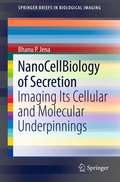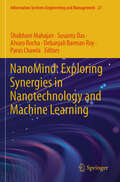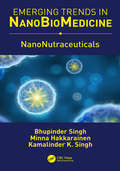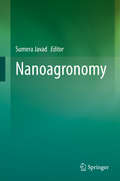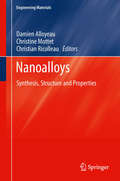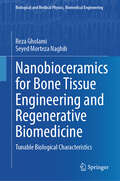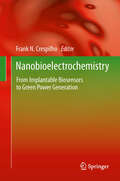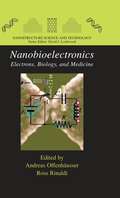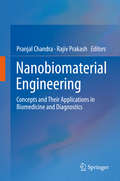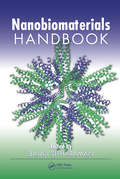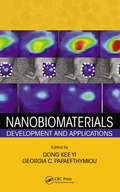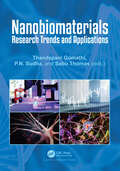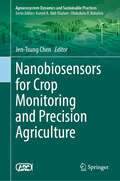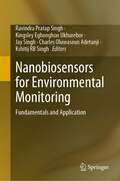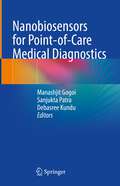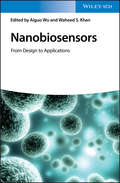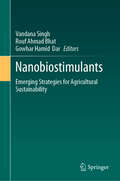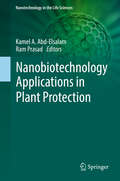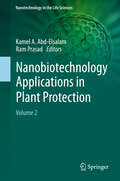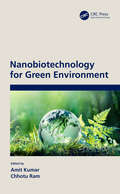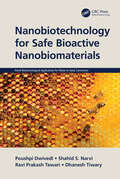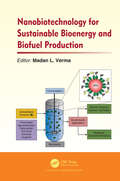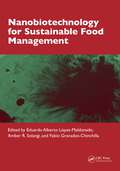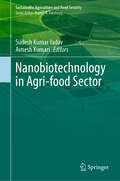- Table View
- List View
NanoCellBiology of Secretion
by Bhanu P. JenaUnderstanding live cells at the single molecule level is the most important and single major challenge facing biology and medicine today. Over the past 15 years, there has been a renewed understanding of living cells at the molecular level. Atomic Force Microscopy, Laser Force Microscopy, single secretory vesicle patch clamp studies, highresolution electron microscopy, and x-ray diffraction, are some of the tools now being used to unravel the intricacies of a living cell at the molecular level. Opening with an explanation of Materials and Methods, NanoCellBiology then moves through discussions of porosome discovery, calcium and SNARE-induced fusion, and vesicle swelling before winding up in a final chapter of conclusions and future studies. Succinctly packaged as SpringerBrief, this book is a must for those studying or conducting research in cell biology, biochemistry or nanobiology/nanotechnology. This book will be invaluable to faculty & graduate students involved in Nano Courses; Cell Biology Courses; Biophysics Courses; and Biochemistry Courses as well as practicing Cell Biologists, Biochemists and BioPhysicists.
NanoMind: Exploring Synergies in Nanotechnology and Machine Learning (Information Systems Engineering and Management #27)
by Alvaro Rocha Shubham Mahajan Paras Chawla Susanta Das Debanjali Barman RoyNanoMind" serves as a captivating exploration at the crossroads of nanotechnology and machine learning, revealing the profound synergies between these two groundbreaking fields. At its core, the book is a guided tour through the intricate realms of nanoscale materials and artificial intelligence, illuminating their combined potential to reshape the landscape of innovation. The journey begins with an introductory chapter, setting the stage for the convergence of nanotechnology and machine learning. Readers are introduced to the fundamental principles and applications of nanoscale materials, laying the groundwork for a deeper understanding of the nano-world. Simultaneously, the basics of machine learning are demystified, providing a comprehensive overview of the methodologies and concepts that underpin AI. "Nanoscale Sensing and Imaging" takes readers into the realm of advanced technologies, showcasing how machine learning enhances our ability to sense and image materials at the nanoscale. The narrative then seamlessly transitions to the creation and optimization of materials with nano-enhancements in "Nano-Enabled Materials." This section demonstrates how the marriage of nanotechnology and machine learning can lead to the development of materials with unprecedented properties, fostering innovation in diverse industries. The exploration extends into the field of healthcare with "Machine Learning in Nanomedicine," unveiling how AI at the nanoscale is transforming diagnostics, drug delivery, and personalized medicine. "Quantum Computing and Nanotechnology" delves into the cutting-edge intersection of quantum computing, nanotech, and machine learning, showcasing the potential for revolutionary advancements in computation and problem-solving. However, the journey isn't without its challenges. The book devotes a section to "Challenges and Ethical Considerations," addressing the complexities and ethical dimensions associated with the convergence of nanotechnology and machine learning. This discussion ensures that readers are equipped to navigate the ethical landscape responsibly.
NanoNutraceuticals
by Bhupinder SinghThis book will be a comprehensive account of the various facets of nutraceuticals domain. The peruser of this book will find details on various nanotech approaches to nutraceuticals, prebiotics and probiotics, along with their specific applications.
Nanoagronomy
by Sumera JavadIn this age of population explosion and depleting natural resources, this book offers new techniques to produce more from agricultural crops at a lower cost. The field of agronomy addresses this issue and interacts with the fields of agriculture, botany, and economics. Nanotechnology and nanoparticles play a role in agronomy. This book will join the techniques from both fields to construct one comprehensive book. Students of agriculture, physics, nanotechnology, and plant sciences will benefit equally from this work.
Nanoalloys
by Christine Mottet Christian Ricolleau Damien AlloyeauBimetallic nanoparticles, also called nanoalloys, are at the heart of nanoscience because of their ability to tune together composition and size for specific purposes. By approaching both their physical and chemical properties, Nanoalloys: Synthesis, Structure & Properties provides a comprehensive reference to this research field in nanoscience by addressing the subject from both experimental and theoretical points of view, providing chapters across three main topics: Growth and structural properties Thermodynamics and electronic structure of nanoalloys Magnetic, optic and catalytic properties The growth and elaboration processes which are the necessary and crucial part of any experimental approach are detailed in the first chapter. Three chapters are focused on the widely used characterization techniques sensitive to both the structural arrangements and chemistry of nanoalloys. The electronic structure of nanoalloys is described as a guide of useful concepts and theoretical tools. Chapters covering thermodynamics begin with bulk alloys, going to nanoalloys via surfaces in order to describe chemical order/disorder, segregation and phase transitions in reduced dimension. Finally, the optical, magnetic and catalytic properties are discussed by focusing on nanoparticles formed with one element to track the modifications which occur when forming nanoalloys. The range and detail of Nanoalloys: Synthesis, Structure & Properties makes it an ideal resource for postgraduates and researchers working in the field of nanoscience looking to expand and support their knowledge of nanoalloys.
Nanobioceramics for Bone Tissue Engineering and Regenerative Biomedicine: Tunable Biological Characteristics (Biological and Medical Physics, Biomedical Engineering)
by Reza Gholami Seyed Morteza NaghibThis book presents the tunable biological characteristics of nanobioceramics and focuses on some challenges in bone tissue engineering and regenerative medicine. Synthetic composite-based materials and scaffolds should be biodegradable, biocompatible and supply sufficient structural aid for cell migration, along with oxygen, waste, and nutrient carriage to accelerate bone regeneration process and remodeling in defects. These properties may be reached by functioning tunable physical features, including absorption rate, degradation rate, modulus, porosity, and swelling by adjustments with the addition of ceramic phases and copolymers as synthetic composite scaffolds. Synthetic bioceramics seek to imitate the natural hydroxyapatite (HA) crystal creation located in bone. These ceramics, particularly calcium phosphates, have exhibited great osteoinductivity, osteoconductivity, and biocompatibility. Lately, silicon-based glass-ceramics have been investigated as a substitution of calcium phosphates. Several members of this collection exhibit high bioactivity, have attractive mechanical strength, and are known to increase cell proliferation, adhesion, and mineralization of extracellular matrix. Moreover, antibacterial properties of some nanostructured bioceramics established significant interests in avoiding implants rejection in surgery and biomedicine.
Nanobioelectrochemistry
by Frank N. CrespilhoNanobioelectrochemistry covers the modern aspects of bioelectrochemistry, nanoscience and materials science. The combination of nanostructured materials and biological molecules enables the development of biodevices capable to detect specific substances. Furthermore, by using the bioelectrochemistry approach, the interaction between bio-systems and nanostructured materials can be studied at the molecular level, where several mechanisms of molecular behavior are elucidate from redox reactions. The combination of biological molecules and novel nanomaterials components is of great importance in the process of developing new nanoscale devices for future biological, medical and electronic applications. This book describes some of the different electrochemical techniques that can be used to study new strategies for patterning electrode surfaces with enzymes, organelles, cells and biomimetic systems. Also, it focuses on how enzymes and microorganisms can be used as biological catalysts in fuel cells for green power generation. By bringing together these different aspects of nanobioelectrochemistry, this book provides a valuable source of information for many students and scientists.
Nanobioelectronics - for Electronics, Biology, and Medicine
by Ross Rinaldi Andreas OffenhäusserThe range of themes addressed in this book emphasize key aspects and the future perspectives of nano-bioelectronics. The book discusses the electronic coupling of DNA and proteins with electronic devices to build new information systems and to apply the systems as biosensors. The exploitation of networks of neurons connected with electronic devices in future information processing systems and the use of nano-objects to assess cellular function is also discussed in detail. The topics of these hybrid nano-bioelectronic systems are both interesting for fundamental research and to enhance industrial competitiveness through research, education, and transfer of technology.
Nanobiomaterial Engineering: Concepts and Their Applications in Biomedicine and Diagnostics
by Pranjal Chandra Rajiv PrakashThis book comprehensively documents the application of Nanobiomaterials in the field of bio-medicine and diagnostics technologies by involving classical concepts/examples. Nanobiotechnology is an emerging area which encompasses all the facets of research of nano and biomaterials with their interaction with biological systems. The book briefly summarizes the various types of Nanomaterial’s, and highlights the recent developments in the synthesis of the nanomaterials for the diagnostic and therapeutic biomedical applications. It skilfully reviews the utilization of the nanomaterials alone or in combination with other bio-molecules as a contrast enhancer in in-vivo imaging, Nano-Theranostics, drug delivery, and sensing transducer matrix. It also discusses the current research on designing of the new Nanobiomaterials and their implementation in numerous fields including bio-medicine and diagnostics. Finally, it summarizes the future prospects and the commercial viability of Nanobiomaterials in the human health care.
Nanobiomaterials Handbook
by Balaji SitharamanNanobiomaterials exhibit distinctive characteristics, including mechanical, electrical, and optical properties, which make them suitable for a variety of biological applications. Because of their versatility, they are poised to play a central role in nanobiotechnology and make significant contributions to biomedical research and healthcare. Nanobio
Nanobiomaterials: Development and Applications (Advances in Materials Science and Engineering)
by Dong Kee Yi Georgia C. PapaefthymiouThere is a continuous exchange of ideas taking place at the border of the biological and physical sciences in many areas of nanoscience. Nanotechnology uses biomimetic or bio-inspired processes to produce nanosized materials for applications in biology and other fields. In return, the fruits of nanotechnology are applied to expanding areas of biome
Nanobiomaterials: Research Trends and Applications
by Sabu Thomas P. N. Sudha Thandapani GomathiNanobiomaterials: Research Trends and Applications – Biomaterials are derived from natural resources such as plants, animals and marine sources. These biomaterials have advanced applications, across a range of key industries due to their low cost, being easy to process, being biocompatible and so on. The modification of biomaterials in the nanoform enhances their applications. The book begins with an overview of nanobiomaterials, processing, classifications, fabrication and sustainability. In-depth chapters in Part I address the most recent methods and techniques for physicochemical characterisation, processing of blends and composites based on nanomaterials, and separation. Chapters in Part II focus on the biological and biomedical applications specifically in antimicrobial chemotherapy, drug delivery, tissue engineering, cancer therapeutics, robust biosolar cells, and 3D printing. The chapters in Part III mostly focus on environmental applications, including wastewater treatment, water desalination, bioremediation, and agricultural uses. The book is extremely useful for scientists, R&D specialists, designers, and engineers across sectors and disciplines who are interested in using biopolymers for parts and products.
Nanobiosensors for Crop Monitoring and Precision Agriculture (Sustainability Sciences in Asia and Africa)
by Jen-Tsung ChenNanobiotechnology has been intensively investigated for decades and is thus well-recognized as a promising approach for advancing sustainable agriculture, particularly proving precision and smart tools based on engineered nanoparticles/nanomaterials. Among them, nanosensors and nanobiosensors have the potential to revolutionize agricultural practices by sensing, detecting, and monitoring cellular processes such as signal transduction and plant hormone dynamics, crop performances, and soil/environmental conditions for precision and even real-time management of fertilizers, pesticides, plant growth/yield/quality, stress responses, and post-harvest processes. In the international book market, there is a gap in providing an updated comprehensive book resource for readers who are interested in materials science and nano-biotechnology particularly, the detailed part of nano-biosensors for agri-food applications. Therefore, this book bridges the knowledge gap by providing a complete guide to nano-biosensors from their fundamentals to current agricultural applications, which presents a series of review-type chapters organized by diverse experts. This book consists of 14 chapters, including subtopics such as optical nanobiosensors, calorimetric nanobiosensors, immuno-nanobiosensors, enzymatic nanobiosensors, and apta-nanobiosensors, for their synthesis, action, and applications. This book provides an updated overview of ethical considerations and regulations for nanotechnology in agri-food applications.
Nanobiosensors for Environmental Monitoring: Fundamentals and Application
by Charles Oluwaseun Adetunji Ravindra Pratap Singh Kshitij Rb Singh Kingsley Eghonghon Ukhurebor Jay SinghThis book entails detailed information on the utilization of nanobiosensor as an effective technology for the effective detection, monitoring, and management of environmental contaminations to ensure its sustainability and humanity's well-being. The higher level of anthropogenic action has been identified as a threat to humankind's existence due to the higher level of xenobiotic and toxic substances that could interrupt the normal ecosystem. This has prompted numerous agencies both locally and internationally that could play a significant role in environmental pollution mitigation. The application of nanobiosensor has been identified as a sustainable technique that could be applied to ensure proper detection and identification of several environmental contaminants. Nanomaterial’s possible applications created an innovative domain called nanomaterials based biosensors machinery as one of nanotechnology's ultimate sub-divisions. The application of nanomaterials based biosensors machinery and their advancements could be applied globally to resolve numerous environmental sectors' challenges to guarantee the environment's quality and safety. The book will be an excellent collection of reviews based on contemporary research and developments on nanomaterials utilization and applications in environmental monitoring along with their prospects. The book will attempt to give a comprehensive idea of nanomaterial concepts for nanobiosensors applications in an environmental context to help students, researchers, and professionals/practitioners recognize nanomaterials' significance in the environmental domain. The book will also help understand and address the environmental sectors' complications via nanomaterials' utilization and applications. Hence, this book will serve as a textbook and will help students, professionals/practitioners, scientists, researchers, and academicians in various research domains.
Nanobiosensors for point-of-care medical diagnostics
by Manashjit Gogoi Sanjukta Patra Debasree KunduThis book examines the role of nanobiosensors in point-of-care applications for personalized healthcare and management. It begins by discussing various biomaterials that are used for the development of biosensors in medical diagnostics, and reviews advances in their fabrication and the miniaturization of biosensor devices for lab-on-chip analysis. In turn, it explores the rapidly evolving applications of nanomaterials in the context of biomaterial diagnostics. The book also explores the immense potential of biosensors in medical diagnostics, where they are increasingly being used to detect a wide range of biomolecules and biomarkers. In closing, it discusses the current challenges and outlines the future role of nanobiosensors in the development of next-generation point-of-care applications.
Nanobiosensors: From Design to Applications
by Aiguo Wu Waheed S. KhanContaining cutting edge research on the hot topic of nanobiosensor, this book will become highly read Biosensor research has recently re-emerged as most vibrant area in recent years particularly after the advent of novel nanomaterials of multidimensional features and compositions. Nanomaterials of different types and striking properties have played a positive role in giving the boost and accelerated pace to biosensors development technology. Nanobiosensors - From Design to Applications covers several aspects of biosensors beginning from the basic concepts to advanced level research. It will help to bridge the gap between various aspects of biosensors development technology and applications. It covers biosensors related material in broad spectrum such as basic concepts, biosensors & their classification, biomarkers & their role in biosensors, nanostructures-based biosensors, applications of biosensors in human diseases, drug detection, toxins, and smart phone based biosensors. Nanobiosensors - From Design to Applications will prove a source of inspiration for research on biosensors, their local level development and consequently using for practical application in different industries such as food, biomedical diagnosis, pharmaceutics, agriculture, drug discovery, forensics, etc. Discusses the latest technology and advances in the field of nanobiosensors and their applications in human diseases, drug detection, toxins Offers a broad and comprehensive view of cutting-edge research on advanced materials such as carbon materials, nitride based nanomaterials, metal and metal oxide based nanomaterials for the fast-developing nanobiosensors research Goes to a wide scientific and industry audience Nanobiosensors - From Design to Applications is a resource for polymer chemists, spectroscopists, materials scientists, physical chemists, surface chemists, and surface physicists.
Nanobiostimulants: Emerging Strategies for Agricultural Sustainability
by Vandana Singh Rouf Ahmad Bhat Gowhar Hamid DarThe book describes how nanobiostimulants, which are nanoscale materials that can enhance plant growth and productivity, have the potential to revolutionize sustainable agriculture practices. The book covers a wide range of topics, including the properties and functions of nanobiostimulants, the mechanisms behind their effects on plant growth, and the potential risks associated with their use. It also discusses how nanobiostimulants can be used to improve soil health and nutrient uptake, enhance plant resistance to environmental stresses, and increase crop yields. Overall, the book provides a comprehensive overview of the emerging field of nanobiostimulants and its potential applications in sustainable agriculture. It will be of interest to researchers, students, and professionals in the fields of agriculture, nanotechnology, and environmental science.
Nanobiotechnology Applications in Plant Protection (Nanotechnology in the Life Sciences)
by Ram Prasad Kamel A. Abd-ElsalamNanotechnology can target specific agricultural problems related to plant pathology and provide new techniques for crop disease control. Plant breeders and phytopathologists are needed who can apply nanogenomics and develop nanodiagnostic technologies to accurately advance the improvement process and take advantage of the potential of genomics. This book serves as a thorough guide for researchers working with nanotechnology to address plant protection problems.Novel nanobiotechnology methods describe new plant gene transfer tools that improve crop resistance against plant diseases and increase food security. Also, quantum dots (QDs) have emerged as essential tools for fast and accurate detection of particular biological markers. Biosensors, QDs, nanostructured platforms, nanoimaging, and nanopore DNA sequencing tools have the potential to raise sensitivity, specificity, and speed in pathogen detection, thereby facilitating high-throughput analysis and providing high-quality monitoring and crop protection. Also, this book deals with the application of nanotechnology for quicker, more cost-effective, and precise diagnostic procedures of plant diseases and mycotoxins. Applications of nanotechnology in plant pests and disease control, antimicrobial mechanisms, pesticides remediation and nanotoxicity on plant ecosystem and soil microbial communities are discussed in detail. Moreover, the application of specific nanomaterials including silver, copper, carbon- or polymer-based nanomaterials and nanoemulsions are also discussed. Crops treated with safe nanofertilizers and nanopesticides will gain added value because they are free of chemical residues, decay and putative pathogens for human health, sustaining the global demand for high product quality.
Nanobiotechnology Applications in Plant Protection: Volume 2 (Nanotechnology in the Life Sciences)
by Ram Prasad Kamel A. Abd-ElsalamNanobiotechnology Applications in Plant Protection: Volume 2 continues the important and timely discussion of nanotechnology applications in plant protection and pathology, filling a gap in the literature for nano applications in crop protection. Nanobiopesticides and nanobioformulations are examined in detail and presented as powerful alternatives for eco-friendly management of plant pathogens and nematodes. Leading scholars discuss the applications of nanobiomaterials as antimicrobials, plant growth enhancers and plant nutrition management, as well as nanodiagnostic tools in phytopathology and magnetic and supramagnetic nanostructure applications for plant protection. This second volume includes exciting new content on the roles of biologically synthesized nanoparticles in seed germination and zinc-based nanostructures in protecting against toxigenic fungi. Also included is new research in phytotoxicity, nano-scale fertilizers and nanomaterial applications in nematology and discussions on Botyris grey mold and nanobiocontrol. This book also explores the potential effects on the environment, ecosystems and consumers and addresses the implications of intellectual property for nanobiopesticides. Further discussed are nanotoxicity effects on the plant ecosystem and nano-applications for the detection, degradation and removal of pesticides.
Nanobiotechnology for Green Environment
by Amit Kumar Chhotu RamThe book examines environmental issues and their solutions with advancements in biotechnology and nanotechnology. This book will focus on environmental friendly waste management, wastewater treatment, and utilization of wastes for energy. As humanity is struggling for clean air, water and even contaminant free food, our society must ponder the condition of environment. This book covers a variety of environmental issues and how they could be solved through innovations in science, engineering and technology. The authors examine the use of biotechnological methods to remediate wastewater, toxic organic compounds and sludge management problems. The topics include different research disciplines such as water and wastewater treatment, solid waste management and utilization of wastes for energy. This book will be useful for researchers, students, scientists and academicians who are working in multidisciplinary areas like microbiology, biotechnology, nanotechnology to address environmental issues such as water and wastewater treatment, solid waste management and energy resources. Nanobiotechnology for Green Environment covers a variety of environmental issues and how they could be solved through innovations in science, engineering and technology.
Nanobiotechnology for Safe Bioactive Nanobiomaterials (Novel Biotechnological Applications for Waste to Value Conversion)
by Dhanesh Tiwary Poushpi Dwivedi Shahid S. Narvi Ravi Prakash TewariThis book begins with an introduction of nanobiotechnology, followed by biosyntheses of AgNPs, development of silver/chitosan (Ag/CS) polymer nanocomposites, synthesis of silver/chitosan-g-poly acrylamide (Ag/CS-g-PAAm) nanocomposite hydrogel and silver/chitosan/poly vinyl chloride (Ag/CS/PVC) blend. Finally, it presents novel bioengineering of polyfunctional metallic nanostructures other than Ag, emphasizing biomass utilization and value-added conversion over an extended span, including life cycle assessment of the synthesized nanostructures. Features: Includes prospective cost effective, eco-friendly, and safe nanomaterials, synthesized through facile paths Covers the synergistic effect of phytochemicals and nano-Ag antimicrobial agents from an antiviral perspective Includes surface coating systems and super absorbent materials for biomedical purposes Examines nanobiotechnological applications for generating nanoalloys with synchronized nanostructural arrangement of alkaline earth metals and nanoscale dots of transition metals Explores the life cycle assessment of synthesized nanomaterials This book aims at researchers and graduate students in biomaterials, chemical engineering, green chemistry, nanomaterials, and biotechnology.
Nanobiotechnology for Sustainable Bioenergy and Biofuel Production
by Madan L. VermaNanobiotechnology for Sustainable Bioenergy and Biofuel Production provides insights into the most recent innovations, trends, concerns and challenges in the production of biofuels. This book highlights a number of key research topics and practical applications of modern nanomaterials and nanocomposite-driven enzyme biotechnology for biofuels production, including the advances in the nanoscaffolds design (nanomaterials support) for immobilizing bioenergy producing enzymes (nanobiocatalyst system), the recent trends in biomass processing (untreated/treated agriculture and food waste, grasses, algal, etc.) using advanced nanobiocatalysts for biofuels production and the scale-up study of bioenergy production using nanomaterials immobilized enzymes and biofuel harvesting using nanomaterials. At the outset of new nanobiotechnology applications in biofuel production, there is a need for a new resource in the bioenergy field. This book delivers an overview of the contributions of biofuel production and the most up-to-date advances in nanobiotechnology to a diverse audience ranging from post-graduate students to researchers in biochemical engineering, biotechnology, bioremediation and environmental studies and pharmaceutical professionals. Key Features • Outlines the most recent nanobiotechnological advances in biofuels and bioenergy for biofuels productions • Covers biodiesel, bioethanol, biomethane, biohydrogen, biorefineries and biofuel harvesting using nanomaterials • Explains the scale-up nanobiotechnological study of biofuel production at the bioreactor level
Nanobiotechnology for Sustainable Food Management
by Amber R. Solangi Fabio Granados-Chinchilla López-Maldonado, Eduardo AlbertoAmong the most novel and ever-growing approaches to improving the food industry is nanobiotechnology. In this book, the prospective role of nanobiotechnology in food which includes quality control and safety through nanosensors and biosensors, targeted delivery of nutrients, controlled release of nutrients, proteins, antioxidants, and flavors through encapsulation and enzymatic reactions for food fortification of fat-soluble compounds is discussed. Along the chapters of this book, nanobiotechnological techniques are addressed in detail with specific emphasis on food science applications.Features: Discusses nanobiotechnology in food for quality control and safety Covers food processing and packaging for food safety Explores the positive role of nanomaterials towards the sustainability of food Provides efficient, real, and sustainable solutions to pertinent global problems Includes case studies and research directions of the nanobiotechnology This book is aimed at researchers and graduate students in nanotechnology and food engineering.
Nanobiotechnology in Agri-food Sector (Sustainability Sciences in Asia and Africa)
by Sudesh Kumar Yadav Avnesh KumariThis book discusses the role of nanobiotechnology in genetic engineering, abiotic stress, nanobionics, postharvest reduction, soilless farming, climate change, precision agriculture, food packaging and processing. The chapters provide a systematic approach to the applications of nanobiotechnology in the agri-food sector. Nanotechnology provides various methods, protocols and nanoparticles for improving the performance of existing methods and protocols. It has the potential to improve the agricultural productivity, efficiency of agrochemicals and augmentation of plant functions. In the food sector, nanotechnology can significantly contribute to food packaging and processing industries. This book covers the untapped potential of nanobiotechnology in improving the productivity, performance, and efficiency of the agri-food sector. This book aids researchers, academicians, and agriculture scientists and nanobiotechnologists in understanding the advantages and broad applications of nanobiotechnology in the agri-food sector.
Nanobiotechnology in Agriculture: An Approach Towards Sustainability (Nanotechnology in the Life Sciences)
by Khalid Rehman Hakeem Tanveer Bilal PirzadahAgriculture is considered as a backbone of developing nations as it caters the needs of the people, directly or indirectly. The global agriculture currently faces enormous challenges like land degradation and reduced soil fertility, shrinking of land, low production yield, water accessibility and a dearth of labor due to evacuation of individuals from farming. Besides, the global population increases at an exponential rate and it is predicted that the global population will be 9 billion by 2050 that in turn leads to food crisis in near future. Although, green revolution revolutionizes the agriculture sector by enhancing the yield but it was not considered as a sustainable approach. Exorbitant use of chemical fertilizers and pesticides to boost the crop yield is definitely not a convenient approach for agriculture sustainability in the light of the fact that these chemical fertilizers are considered as double-edged sword, which on one hand enhance the crop yield but at the same time possess deleterious effect on the soil microflora and thus declines its fertility. Besides, it cause irreversible damage to the soil texture and disrupts the equilibrium in the food chain across ecosystem, which might in turn lead to genetic mutations in future generations of consumers. Thus, the increased dependence on fabricated agricultural additives during and post green revolution has generated serious issues pertaining to sustainability, environmental impact and health hazards. Therefore, nano-biotechnology has emerged as a promising tool to tackle the above problems especially in the agriculture sector. Nano-agribusiness is an emerged field to enhance crop yield, rejuvenate soil health, provide precision farming and stimulate plant growth. Nano-biotechnology is an essential tool in modern agriculture and is considered as a primary economic driver in near future. It is evaluated that joining of cutting edge nanotechnology in agribusiness would push the worldwide monetary development to approximately US$ 3.4 trillion by 2020 which clearly indicates that how agri-nanobiotechnology plays a pivotal role in the agricultural sector, without any negative impact on the environment and other regulatory issues of biosafety. Agri-nanobiotechnology is an innovative green technology, which provides the solution to global food security, sustainability and climate change. The current book is presenting the role of nano-biotechnology in modern agriculture and how it plays a pivotal role to boost the agri-business.
